The Historical Sew Monthly Challenge #5 for 2017 is Literature.
The written word has commemorated and immortalised fashions for centuries, from the ‘gleaming’ clothes that Trojans wore before the war, to Desdemona’s handkerchief, ‘spotted with strawberries’, to Meg in Belle Moffat’s borrowed ballgown, and Anne’s longed for puffed sleeves.
In this challenge make something inspired by literature: whether you recreate a garment or accessory mentioned in a book, poem or play, or dress your favourite historical literary character as you imagine them.
To inspire you, here are some literary clothing quotes, and the historical examples they might have been referring to. My examples are mainly of women’s dress: fellow mod Bránn of Matsukaze Workshops will be writing about men’s clothes in literature shortly (but I couldn’t resist slipping in a few male examples anyway.)
I could never better stead thee than now. Put money in thy purse. Follow thou the wars, defeat thy favor with an usurped beard. I say, put money in thy purse. It cannot be long that Desdemona should continue her love to the Moor–put money in thy purse–nor he his to her.
~ Shakespeare, Othello, Act 1, Scene 3, Page 14. 1603
She perceived a gentlemen of that delicacy for a man as she was struck with wonder, his sweetness and fairness such as the rarest painters must confess themselves unable to counterfeit such perfections, and so exquisite proportion. He had a mantle richly embroidered in pearl and gold, the colour of that and his other apparel being watchet* suitably embroidered; his hair fair and shining, so young he was as he had but the sign of a beard. Arms he had none, save a sword to defend himself, or offend his enemies
~ Lady Mary Wroth, The Countess of Montgomery’s Urania. 1621
Watchet is light or sky blue. Urania is the earliest known published work of English prose fiction by a woman.
My choice is from a few decades later than Wroth’s work, simply because it matches the description so perfectly:
I dressed myself in a flower’d Satten, that was my Lady’s, that looked quite fresh and good, and which was given me at first by my master; and the ladies, who had not seen me out of my homespun before, made me an abundance of fine compliments, as soon as they saw me first.
~Samuel Richardson, Pamela; or, Virture Rewarded. 1740
Pamela gives us quite a few clothing descriptions, as Pamela mentions most of the garments that she is given by her master, Mr B, which had previously belonged to his mother, to whom Pamela was maidservant, and compares them to the homespun she wore as maid:
Due to the phenomenal popularity of Pamela, there are numerous illustrations for the book, and other artworks, though most depict Pamela in fashionable dress, even when showing her as a maid, especially after Richardson ‘gentrified’ Pamela’s speech and origins in subsequent editions of Pamela, due to criticism over the social gap between the maid and her lecherous employer-later-husband.
I wish you could take the white and silver to be married in. It’s the worst luck in the world, in anything but white.
~ Oliver Goldsmith, The Good-Natur’d Man. 1768
Goldsmith’s maid’s fretting over her mistresses’ choice of gown for her elopement is one of the earlier pieces of written evidence of an association between white frocks and weddings (though Pamela also chooses a ‘rich white Sattin night-gown’, ‘night-gown’ for her wedding frock). However, the maid’s superstition may not have been widely known before the play: there is also evidence the play helped popularise white wedding frocks, such as this 1770s gown:
Dress is at all times a frivolous distinction, and excessive solicitude about it often destroys its own aim. Catherine knew all this very well; her great aunt had read her a lecture on the subject only the Christmas before; and yet she lay awake ten minutes on Wednesday night debating between her spotted and her tamboured muslin, and nothing but the shortness of the time prevented her buying a new one for the evening.
Jane Austen, Northanger Abbey, written 1803, published 1817
Jane Austen’s personal writing and letter reveal that she loved clothes, and paid a great deal of attention to them, but descriptions of dress in her published novels are spare: instead, she uses a focus on dress to gently mock her characters. In the above description one suspects that Austen knew Catherine’s dilemma very well on a personally!
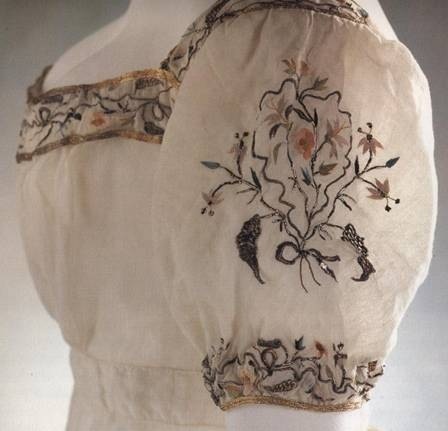
Muslin evening dress 1812-1815. Embroidered with single strands of very fine silk, the stalks are embroidered in silver gilt thread.
After tea, when Mr. Van Brunt was gone, and the tea things cleared away, Ellen had the pleasure of finding out the mystery of the brass kettle and the white maple bark. The kettle now stood in the chimney corner. Miss Fortune, seating herself before it, threw in all of Ellen’s stockings, except one pair, which she flung over to her saying, “There – I don’t care if you keep that one.” Then tucking up her sleeves to the elbows, she fished up pair after pair out of the kettle, and wringing them out, hung them on chairs to dry. But, as Ellen had opined, they were no longer white, but of a fine slate colour.
~ Elizabeth Wetherell (aka Susan Warner), The Wide, Wide World, 1850
The Wide, Wide World is one of my least favourite pieces of historical writing, because Wetherell’s heroine is snobbish, classist, spoiled and solves all her problems by sitting down and crying until someone rescues her. By modern standards, I can find a lot more to admire in the villain of the work: Miss Fortune, who is a ‘bad’ woman according to the mores of the time, because she disdains pointless class distinctions, and dares to live alone, earn her own living, and marry for mutual respect, irregardless of social standing.
That aside, the book has some of the best descriptions of textiles, clothing, and sewing paraphernalia, including a detailed inventory of a sewing kit. The paragraph about dyeing white cotton socks to a more practical colour is also wonderfully delicious!
I never feel as if I was dressed right. My things seemed elegant at home, and I thought I’d be over over-dressed if anything; but I look contrified and dowdy here. No time or money to change now, even if I knew how to do it,” answered the other, glancing anxiously at her bright pink silk gown, trimmed with silk lace.
~ Louisa May Alcott, Jo’s Boys, 1886
This gown is definitely a lighter pink, and probably far more expensive, than the one Alcott describes, but I suspect that Alcott would have found it anything but simple and elegant.
It was understood that at eleven o’clock the women and children of the summer colony had the sea to themselves. First the women undressed, pulled on their bathing dresses and covered their heads in hideous caps like sponge bags…
~ Katherine Mansfield, At the Bay, 1922
Flora’s own dress was harmonious in tones of pale and dark green. She wore no jewels, and her long coat was of viridian velvet.
~Stella Gibbons, Cold Comfort Farm. 1932
I imagine it as something like this, but in celadon rather than olive green, with dark jade insets, instead of sequins:
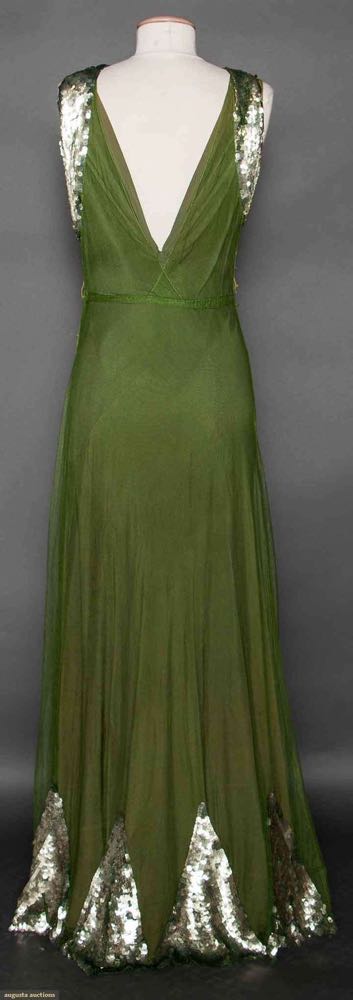
Sequinned evening gown,1930s (back view) Olive green cotton net, sleeveless, low cut B, wide band of silver sequins for Hi collar, long skirt w: pattern of sequined triangles at hem, heavy silk bias cut matching underdress, Augusta Auction
And this, in the aforementioned viridian:
Interestingly, although Flora advises Elphine against dull green, every single item of her own dress which is described by colour in Cold Comfort Farm is green.
Hope you enjoyed the tour through some of my favourite literary clothing mentions. What are yours? Please do share and help with the inspiration!



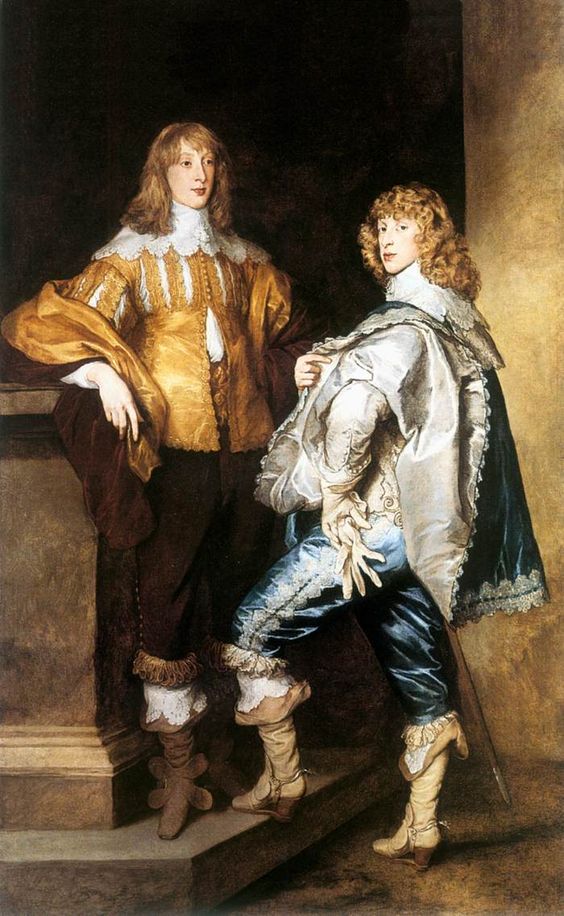




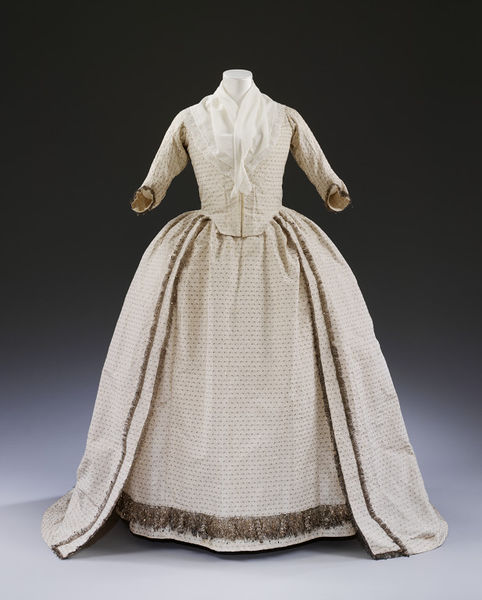
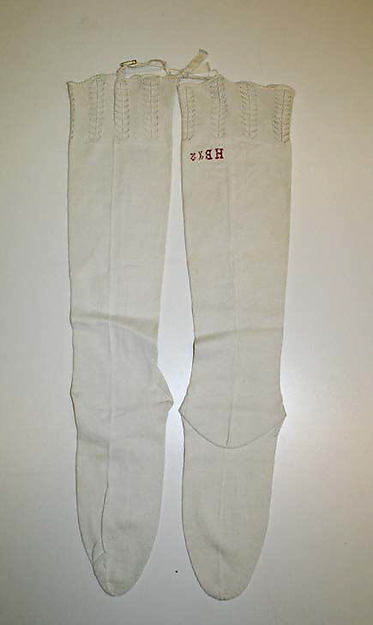


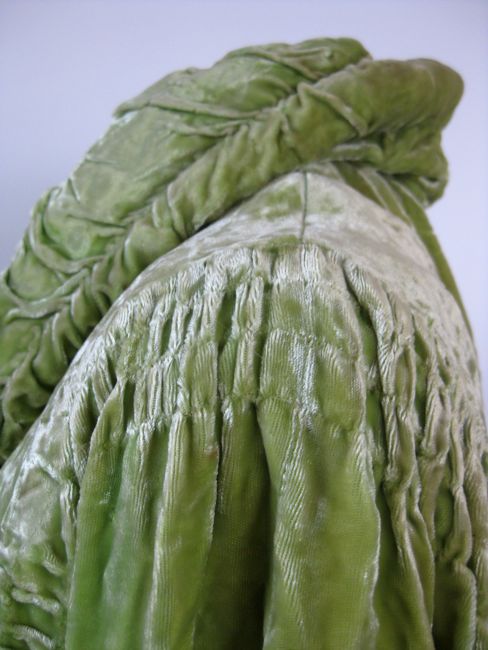
Has that flowered brocade dress been a RTD before, or is it just me liking it so much thinking it should be?
Mine are, in no particular order (and excluding the spotted vs sprigged muslin conundrum you’re already brought up yourself!):
Nancy Blackett and her practical shorts in Picts and Martyrs, by Arthur Ransome. (And her & Peggy’s red knitted hats, all throughout the series.)
And the shrilly woman in orange pyjamas in Coot Club, also by Ransome (part of a bunch of loud and inconsiderate people who had hired a motorboat, anchored in the river, played radio loudly and did not care one bit that they disturbed coots nesting nearby). That was my first ever encounter with the 1930s (English?) sense of pyjamas, and because I had no idea of it, I kept imagining her as not only rude but slovenly, too. 😀 (While, I think, she was in fact just meant to be emulating high fashion Riviera styles and out of touch with the rural and, let’s call it “muddy”, English countryside she was actually vacationing in.)
Thanks to you, now, Patricia Brent, spinster in her outrageous black-and-white outfit, “bad enough for a vicar’s daughter”. 😀
Allison / Alysoun in The Miller’s tale and her rich seductive clothes, whatever they actually looked like.
Gabra and Málinka (two sisters from a Czech series of books that could be likened to Anne of Green Gables somewhat) in Moravian-Wallachian folk costumes (HA! – where Gabra looks great in it while Málinka is a bit too gentle-looking for the style), and later getting some folk embroidery from a different region and using it, if I recall that particular book correctly, as ribbons on their hats.
The dress the suddenly-richer heroine in “The Mystery of the Blue Train” by Agatha Christie tries on and buys. Back when I first read it at a fairly young age I was fascinated by it and wanted one in a colour like it, too, because it was described as complimenting the heroine’s grey eyes, and I have grey eyes. I just didn’t know what colour it was. Turns out, years later now when I remember it, it must have been mauve, apparently in the current subdued sense because I can’t picture Perkins’ loud mauve fitting the description in the book. 😀
http://clothesinbooks.blogspot.cz/2014/10/the-mystery-of-blue-train-by-agatha.html
Nice! Isn’t that outfit description in Patricia Brent just delicious? Actually, isn’t all of Patricia just fabulous? Such a great look at that era!
Gabra and Málinka sounds like something I’d like to read! In the usual parallels between my life and yours, I thought about including an outfit description from one of Armine von Tempski’s (a Hawaiian writer who had a few US bestsellers in the ‘teens and ’20s – enough so that one was even made into a movie with Clara Bow!) books, but it took too much back-explaining, so I left out the Hawaiian dress 😉
Hehe about the woman in orange ‘pyjamas’! No, it just doesn’t translate, just as Pamela’s ‘rich satin night-gown’ as a wedding dress doesn’t make sense until you understand night-gowns in the 18th century sense (an informal gown worn in the morning, not at all for sleeping in!)
Patricia Brent, Spinster is indeed a great look at that era and, as I mentioned on FB, it explained a thing about the following era to me, too.
Alas, a big part of the overall charm of Gabra and Málinka is the local dialect, and that would also not translate.
But it’s autobiographical, and I’ve now found photos! It’s funny and strange to see these people one’s known as characters, and seeing the personalities one knows from the books in the people in the photos…
… most striking here: Gabra is mischievous, playful, stubborn, always full of ideas. Doesn’t she just look like she would be? http://stitnapopov.rajce.idnes.cz/Gabra_a_Malinka,_povedene_cerky_ze_Stitne#Snimek_005.jpg
I seem to have missed a HTML code somewhere. 😀
I’m thinking of a Swedish poet, Anna Maria Lenngren, who among many other satirical pieces wrote a long poem called “A few words to my dear daughter, if I’d had one” in 1798. It’s about how women are expected to quench their literary and intellectual ambitions, and focus on housework instead. One of the stanzas has been frequently quoted; a rough translation (lacking the original’s rhythm and rhymes) could be:
A learned wearing petticoats (so I’ve found)
won’t escape the sting of satire
and [knowledge of] Humanities in women
is considered as mere trinkets.
BTW, where can I post a link to my completed project for challenge #4? Thanks!
Oh, what Christine de Pizan would have said to Anna Maria Lenngren!
Wonderful! I quite enjoy the descriptions of dress given in Patricia Wentworth’s Miss Silver mystery novels – she always slips a few clues to character in, as well as giving an insight into wardrobe habits of the time (e.g. wear it one year for best, one year for second best, and then as long as it will last for housework and gardening).
I like the way some items are described both by the wearer and by someone viewing the wearer and how those descriptions tell you something about the characters – I’m recalling Miss Silver’s fur tippet, which she thinks of as “so warm, so cozy” and a different character describing it as being small and a bit the worse for wear.
Oh this post is so neat, and I really do like the comments.
In many ways, clothes are how women speak and communicate–especially in a patriarchal society. While Fielding is an ambivalent friend to feminism, the clothing descriptions in Pamela make me want to read Shamela and to see if he uses clothing to describe and code his “heroine”.
It is really neat to read interviews with costume designers for that very reason: they decide what a character or plot must communicate without speech.
Ok, anyhow, I like the clothing described in I Capture the Castle. There is a lot of embarrassment, and a lot of fun at the same time.
Oh – the girls’ suits during the department store trip to retrieve the aunt’s furs, dying the clothing (and everything else!) green, Rose’s pink dress, Topaz’s theatrical approach to appearance, Miss Blossom. The book is so vivid, and places you so firmly *in* the story.
That was on my stack of books to pick quotes from for this post, but the post got too long, so I had to leave it off. One of my favourites!
Such a good book! 🙂
Such a good book, and such good comments on this thread!
I think some people look down on excessive descriptions of characters’ outfits as a waste of time, but I think they (and descriptions of food) are some of the most fun details in reading books from the past, and I always enjoy a scene where the heroine adorns herself for a ball or something and we get a loving description of the dress.
One that sticks out to me is this description from Emily’s Quest (1927). I don’t love her as much as I do Anne, but I do love me some mid-1920s evening wear:
“She flung a hasty glance into the mirror before she went down and turned away satisfied. An arrow of rhinestones in her dark hair–she had hair that wore jewels well–lent the necessary note of brilliance to the new dress of silvery-green lace over a pale-blue slip that became her so well. Miss Royal had picked it for her in New York–and Aunts Elizabeth and Laura had looked askance at it. Green and blue was such an odd combination. And there was so little of it. But it did something to Emily when she put it on. Cousin Jimmy looked at the exquisite, shimmering young thing with stars in her eyes, in the old candle-lighted kitchen and said ruefully to Aunt Laura after she had gone, “She doesn’t belong to us in that dress.” ”
And then Aunt Elizabeth goes on to say (killingly) that she looks like an actress. No mentioned if Emily accessorized with her ancient Egyptian necklace that she received as a souvenir from a princess’ tomb.
I’ve read The Wide, Wide World too, and I don’t remember much about it except that I hated it and it included a recipe for hot chocolate that involved raw eggs. So yay for descriptions of food!
thespruce.comIt’s goooooood: Recipe below:
https://www.thespruce.com/viennese-hot-chocolate-1446540
This post is delightful! And I love hearing about everyone’s favourite literature and costume connections.
I’ve just finished reading ,again, ‘Lark Rise to Candleford’ by flora Thompson which gives lots of descriptions of ordinary English country women & childrens clothes in the 1880s / 1890s. Flora was the daughter of a stone mason & her childhood neighbours were very poor agricultural workers families. Clothes were often handed down by richer relations & by daughters in service. No fabric was ever wasted, it was remade, dyed, refashioned then made into clothes for the children & finally made into patchwork quilts or rag rugs, underwear was sewn at home & local dressmakers copied the latest fashions from magazines if someone could afford it, so therefore ordinary peoples clothes haven’t survived & we see mostly clothes from the richest sections of society in museums.
Very much in the same vein are the books by Alison Uttley, Farm on the hill & A country childhood give lot’s of descriptions of clothes of the 1890s.
A lovely post, with books I haven’t heard of which I’ll now try to get hold of, thank you Leimomi
Lovely post! The clothing descriptions I re-read the most, especially when I was 10-15 years old (all well-known; no obscure new treasures here):
-Mary’s Going-to-College dress in Little Town on the Prairie
“Now the basque of Mary’s best dress was ready to try on for the last time. It was brown cashmere, lined with brown cambric. Small brown buttons buttoned it down the front, and on either side of the buttons and around the bottom Ma had trimmed it with a narrow, shirred strip of brown and blue plaid, with red threads and golden threads running through it. A high collar of the plaid was sewed on, and Ma held in her hand a gathered length of white machine-made lace. The lace was to be fitted inside the collar, so that it would fall a little over the top.
“Oh Mary, it’s beautiful. the back fits without a wrinkle, and so do the shoulders,” Laura told her. “And the sleeves look absolutely skin tight to the elbows.”…
They all stood back to admire. The gored skirt of brown cashmere was smooth and rather tight in front, but gathered full around the sides and the back, so that it would be ample for hoops. In front it touched the floor evenly behind it swept into a graceful train that swished when Mary turned. All around the bottom was a pleated flounce.
The overskirt was of the brown-and-blue plaid. It was shirred in front , it was draped up at the sides to show more of the skirt beneath, and at back it fell in rich, full puffs, caught up above the flounced train.
Above all this, Mary’s waist rose slim in the tight, smooth bodice. The neat little bottoms ran up to the soft, white lace cascading under Mary’s chin. The brown cashmere was smooth as paint over her sloping shoulders and down to her elbows; then the sleeves widened. A shirring of the plaid curved around them, and the wide wrists fell open, showing a lining of white lace ruffles that set off Mary’s slender hands.
Mary was beautiful in that beautiful dress.”
-Anne sewing a dress for a wedding in Anne of the Island (how I wanted to inspire these feelings in a man!)
“I’ve come up to ask you to go for one of our old-time rambles through September woods and ‘over hills where spices grow,’ this afternoon,” said Gilbert, coming suddenly around the porch corner. “Suppose we visit Hester Gray’s garden.”
Anne, sitting on the stone step with her lap full of a pale, filmy, green stuff, looked up rather blankly.
“Oh, I wish I could,” she said slowly, “but I really can’t, Gilbert. I’m going to Alice Penhallow’s wedding this evening, you know. I’ve got to do something to this dress, and by the time it’s finished I’ll have to get ready. I’m so sorry. I’d love to go.”
[. . .]
“Is that the dress you’re going to wear tonight?” asked Gilbert, looking down at the fluffs and frills.
“Yes. Isn’t it pretty? And I shall wear starflowers in my hair. The Haunted Wood is full of them this summer.”
Gilbert had a sudden vision of Anne, arrayed in a frilly green gown, with the virginal curves of arms and throat slipping out of it, and white stars shining against the coils of her ruddy hair. The vision made him catch his breath. But he turned lightly away.”
-Amy prinking for Laurie in Little Women
“I do want him to think I look well, and tell them so at home,” said Amy to herself, as she put on Flo’s old white silk ball dress, and covered it with a cloud of fresh illusion, out of which her white shoulders and golden head emerged with a most artistic effect. Her hair she had the sense to let alone, after gathering up the thick waves and curls into a Hebe-like knot at the back of her head.
[. . .]
Having no ornaments fine enough for this important occasion, Amy looped her fleecy skirts with rosy clusters of azalea, and framed the white shoulders in delicate green vines. Remembering the painted boots, she surveyed her white satin slippers with girlish satisfaction, and chasseed down the room, admiring her aristocratic feet all by herself.
[. . .]
She walked up and down the long saloon while waiting for Laurie, and once arranged herself under the chandelier, which had a good effect upon her hair, then she thought better of it, and went away to the other end of the room, as if ashamed of the girlish desire to have the first view a propitious one. It so happened that she could not have done a better thing, for Laurie came in so quietly she did not hear him, and as she stood at the distant window, with her head half turned and one hand gathering up her dress, the slender, white figure against the red curtains was as effective as a well-placed statue.
Oh, I remember the first two quotes very well!
And what an interesting spelling of “sashay” (“Chauseed”)
This is so wonderful! I enjoyed reading your selections. I’ve been thinking about a different Alcott clothing reference this week because it’s May, which is a big month at Alcott’s home (now museum). In particular I’ve been thinking about Meg and Meg’s wedding:
“Neither silk, lace, nor orange flowers would she have. ‘I don’t want a fashionable wedding, but only those about me whom I love, and to them I wish to look and be my familiar self.’
So she made her wedding gown herself, sewing into it the tender hopes and innocent romances of a girlish heart. her sisters braided up her pretty hair, and the only ornaments she wore were the lilies of the valley, which `her John’ liked best of all the flowers that grew.” -Little Women pt2, published 1869
9 years earlier, the “real” Meg, Anna Alcott, was married on 23 May 1860. From her journal:
“I had proposed a very simple white dress meaning to look like a bride, but on deciding it should be in the morning & knowing myself to be neither young nor pretty I laid it aside as unsuitable & wore my riding dress of silvery grey” -Anna Alcott Pratt, August 1860
We still have the original dress in the collection and it comes out for display in Anna’s anniversary month. As I get nearer to Anna’s age (she was 29 when she got married), I find myself understanding more and more of her struggles! I’m hoping to make an 1860s dress this month with the Alcott sisters in mind, although I don’t think it will be finished in time to meet the challenge.
This was a really neat challenge, and I enjoyed the post! It had never really occurred to me to look for clothing descriptions in literature before, for some reason! I ended up going with an object in Thackeray’s Vanity Fair (the green silk purse Becky knits, in the chapter of the same name). There seem to be a whole load of descriptions in clothing there too, although I find them a bit confusing, given that from their descriptions they seem to be clearly Regency clothes, but all the illustrations seem to set the book in the mid 19th century…
Here is my post for this challenge: http://accoutrements-morag.blogspot.ca/2017/05/a-green-knit-purse.html (HSM description is part way down the page).
“Remember who commended thy yellow stockings and wished to see thee ever cross-gartered…”
http://gingerminion.blogspot.com/2017/05/give-me-my-yellow-hose-again-hsm-2017.html